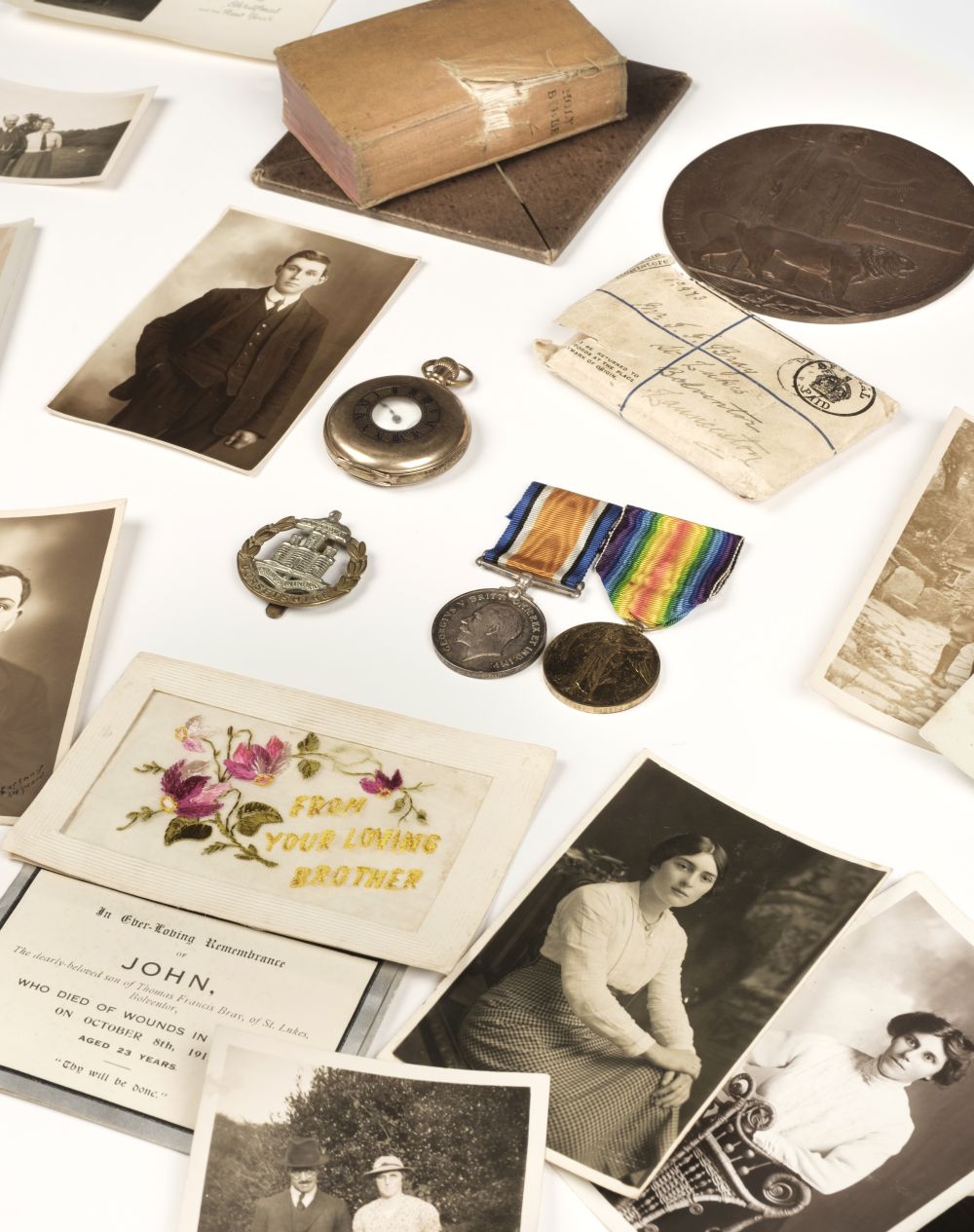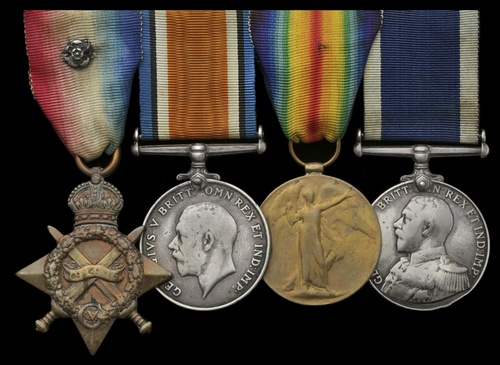An emotive Great War Hedjaz railway operations M.C. group of four awarded to 2nd Lieutenant W. T. Davies, Royal West Surrey Regiment, attached Imperial Camel Corps, late Shropshire Yeomanry, who was decorated for his gallant leadership in the famous raid on Mudowwara Station on 8 August 1918, which place he had earlier reconnoitred with four other officers, the whole attired in Arab dress: undoubtedly known to Lawrence of Arabia, who rode alongside the Camel Corps on many occasions, it seems improbable that the great man was not shown the “Mudowwara Trumpet”, which instrument Davies retained as a souvenir of the raid - and which was sounded at the annual reunions of the Imperial Camel Corps right up until the 1960s Military Cross, G.V.R., in its case of issue; British War and Victory Medals (2 Lieut. W. T. Davies), these in their card boxes of issue; Territorial Force War Medal 1914-19 (1374 Sjt. W. T. Davies, Shrops. Yeo.), generally extremely fine (4) £6000-8000 Footnote M.C. London Gazette 10 September 1918: ‘During the raid on Mudowwara Station on 8 August 1918, he was in charge of the attacking party which he led and directed with conspicuous ability. It was owing to his quickness of action that we incurred few casualties. His demolition work throughout the operations was invaluable.’ William Thomas Davies was born in Shrewsbury in October 1891 and joined the Shropshire Yeomanry in early 1910. Having then served in Egypt as an N.C.O., he was commissioned as a 2nd Lieutenant in the Queen’s Royal West Surrey Regiment in December 1917, and attached to the Imperial Camel Corps in Palestine. And it was in this latter capacity that he would come into close contact with Lawrence of Arabia in the following year, his, and one other company of the Camel Corps, totalling 300 men, being chosen to capture the railway station at Mudowwara. Mudowwara lay on the Hedjaz railway, Lawrence’s favoured hunting ground, and possessed the only significant water supply to cover 150 miles of the line south of Maan. As a result, Lawrence had made two or three attempts to mount an attack on the station in September 1917 but, for assorted reasons, they never got off the ground. And it was only in August 1918 - via the suggestion of his friend Colonel Dawnay - that he got clearance to use two companies of the Imperial Camel Corps, under Colonel Robert Buxton, for a renewed initiative: ‘Dawnay and I sat down with a map and measured that Buxton should march from the Canal to Akaba; thence, by Rumm, to carry Mudowwara by night-attack; thence by Bair, to destroy the bridge and tunnel near Amman; and back to Palestine on August the thirtieth’ (Revolt in the Desert refers). Here, then, Lawrence’s first mention of Buxton and the Imperial Camel Corps, but such were the achievements of this irregular force over the coming weeks - achievements in which Lawrence shared for he delighted in riding alongside them - that he would dedicate an entire chapter in Revolt in the Desert to their story. In late July 1918, he visited Buxton and his men for the first time: ‘Accordingly I went down to Akaba, where Buxton let me explain to each company their march, and the impatient nature of the Allies whom they, unasked, had come to help; begging them to turn the other cheek if there was a row; partly because they were better educated than the Arabs, and therefore less prejudiced; partly because they were very few. After such solemnities came the ride up the oppressive gorge of Itm, under the red cliffs of Nejed and over the breast-like curves of Imran - that slow preparation for Rumm’s greatness - till we passed through the gap before the rock of Khuznail, and into the inner shrine of the springs, with its worship-compelling coolness. There the landscape refused to be accessory, but took the skies, and we chattering humans became dust at its feet.’ It was shortly after this visit that Davies participated in the ‘reconnaissance from Rumm towards Mudowwara in Arab cloaks’, the
An emotive Great War Hedjaz railway operations M.C. group of four awarded to 2nd Lieutenant W. T. Davies, Royal West Surrey Regiment, attached Imperial Camel Corps, late Shropshire Yeomanry, who was decorated for his gallant leadership in the famous raid on Mudowwara Station on 8 August 1918, which place he had earlier reconnoitred with four other officers, the whole attired in Arab dress: undoubtedly known to Lawrence of Arabia, who rode alongside the Camel Corps on many occasions, it seems improbable that the great man was not shown the “Mudowwara Trumpet”, which instrument Davies retained as a souvenir of the raid - and which was sounded at the annual reunions of the Imperial Camel Corps right up until the 1960s Military Cross, G.V.R., in its case of issue; British War and Victory Medals (2 Lieut. W. T. Davies), these in their card boxes of issue; Territorial Force War Medal 1914-19 (1374 Sjt. W. T. Davies, Shrops. Yeo.), generally extremely fine (4) £6000-8000 Footnote M.C. London Gazette 10 September 1918: ‘During the raid on Mudowwara Station on 8 August 1918, he was in charge of the attacking party which he led and directed with conspicuous ability. It was owing to his quickness of action that we incurred few casualties. His demolition work throughout the operations was invaluable.’ William Thomas Davies was born in Shrewsbury in October 1891 and joined the Shropshire Yeomanry in early 1910. Having then served in Egypt as an N.C.O., he was commissioned as a 2nd Lieutenant in the Queen’s Royal West Surrey Regiment in December 1917, and attached to the Imperial Camel Corps in Palestine. And it was in this latter capacity that he would come into close contact with Lawrence of Arabia in the following year, his, and one other company of the Camel Corps, totalling 300 men, being chosen to capture the railway station at Mudowwara. Mudowwara lay on the Hedjaz railway, Lawrence’s favoured hunting ground, and possessed the only significant water supply to cover 150 miles of the line south of Maan. As a result, Lawrence had made two or three attempts to mount an attack on the station in September 1917 but, for assorted reasons, they never got off the ground. And it was only in August 1918 - via the suggestion of his friend Colonel Dawnay - that he got clearance to use two companies of the Imperial Camel Corps, under Colonel Robert Buxton, for a renewed initiative: ‘Dawnay and I sat down with a map and measured that Buxton should march from the Canal to Akaba; thence, by Rumm, to carry Mudowwara by night-attack; thence by Bair, to destroy the bridge and tunnel near Amman; and back to Palestine on August the thirtieth’ (Revolt in the Desert refers). Here, then, Lawrence’s first mention of Buxton and the Imperial Camel Corps, but such were the achievements of this irregular force over the coming weeks - achievements in which Lawrence shared for he delighted in riding alongside them - that he would dedicate an entire chapter in Revolt in the Desert to their story. In late July 1918, he visited Buxton and his men for the first time: ‘Accordingly I went down to Akaba, where Buxton let me explain to each company their march, and the impatient nature of the Allies whom they, unasked, had come to help; begging them to turn the other cheek if there was a row; partly because they were better educated than the Arabs, and therefore less prejudiced; partly because they were very few. After such solemnities came the ride up the oppressive gorge of Itm, under the red cliffs of Nejed and over the breast-like curves of Imran - that slow preparation for Rumm’s greatness - till we passed through the gap before the rock of Khuznail, and into the inner shrine of the springs, with its worship-compelling coolness. There the landscape refused to be accessory, but took the skies, and we chattering humans became dust at its feet.’ It was shortly after this visit that Davies participated in the ‘reconnaissance from Rumm towards Mudowwara in Arab cloaks’, the



/50170/Internet%20Image%204.jpg)


/111486/Internet%20Image%201.jpg)


/82264/Internet%20Image%201.jpg)

/41077/Internet%20Image%201.jpg)
/36297/Internet%20Image%201.jpg)

/44896/Internet%20Image%201.jpg)
Testen Sie LotSearch und seine Premium-Features 7 Tage - ohne Kosten!
Lassen Sie sich automatisch über neue Objekte in kommenden Auktionen benachrichtigen.
Suchauftrag anlegen